KöMaL Problems in Physics, March 2021
Please read the rules of the competition.
Show/hide problems of signs:
 |
Problems with sign 'M'Deadline expired on April 15, 2021. |
M. 403. For some commercially available granular matter (e.g. lentils, rice, egg barley, etc.) determine by measurement what percentage of their storage volume is air.
(6 pont)
 |
Problems with sign 'G'Deadline expired on April 15, 2021. |
G. 737. To how many equal parts should a piece of wire of resistance \(\displaystyle 100~\Omega\) be cut, in order to gain an equivalent resistance of \(\displaystyle 1~\Omega\) when the pieces are connected in parallel?
(3 pont)
solution (in Hungarian), statistics
G. 738. When an earthquake occurs several waves are generated from the centre of the quake. The so called primary waves (P-waves) are the fastest, in our case their propagation speed is 5 km/s. The secondary waves (S-waves) are slower, they travel at a speed of 3 km/h. Two seismic observatories are at a distance of 75 km from each other. In one of them 6 seconds were measured between the detection of the P and S waves, whilst in the other 8 seconds elapsed. At what maximum depth could the centre of the earthquake be?
(4 pont)
solution (in Hungarian), statistics
G. 739. Improperly positioned loads can tip over the fork-lift trunk. Therefore a so-called load capacity chart is attached to the truck (see the figure). Using the chart determine the horizontal distance from the heel of the fork to the axle of the front wheel of the truck, and the horizontal distance between the heel of the fork and the centre of mass of the truck of mass 1200 kg.
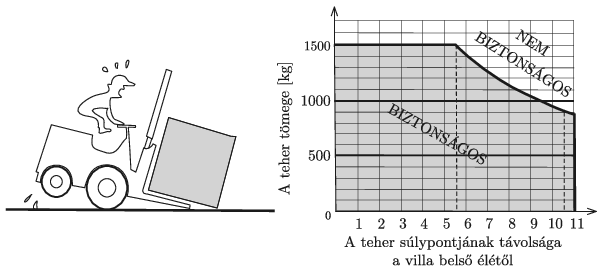
(4 pont)
solution (in Hungarian), statistics
G. 740. The asymmetrical U-shaped tube shown in the figure has a cross-sectional area of \(\displaystyle 2~\mathrm{cm}^2\), and it is filled with mercury. The top of the tube at the left is sealed, thus in this arm, there will be an air column of height 10 cm, at a pressure of 1 atm. How many cm\(\displaystyle {}^3\) of mercury should be filled slowly and carefully into the right arm, in order to decrease the level of mercury in the right arm to half of the original height?
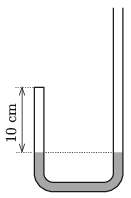
(3 pont)
 |
Problems with sign 'P'Deadline expired on April 15, 2021. |
P. 5305. Mary is sitting in a rotating merry-go-round, admiring the gingerbread she has just received from Ian. The radius of the circular path of the gingerbread is \(\displaystyle R=5\) m, its period is \(\displaystyle T_0=5\) s and the plane of its path is at a height of \(\displaystyle H=3.2\) m. Mary is so careless that she accidentally drops her gift. How far is Mary's hand, which she does not move, from the gingerbread at the moment when the gingerbread touches the ground? Neglect the size of the gingerbread and air resistance.
(4 pont)
solution (in Hungarian), statistics
P. 5306. A bicycle-like vehicle with only one wheel, called unicycle, is at rest in an unstable position. We would like to move further with it. To do this we have to speed up first, then we need to move uniformly and then we have to slow down and leave the unicycle in the original unstable position. How do we need to pedal in order not to fall from the unicycle?

(5 pont)
solution (in Hungarian), statistics
P. 5307. The pumping rate of a pump is 150 cm\(\displaystyle {}^3\)/s. How long does it take to decrease the pressure of the air in a 3-litre container from the normal atmospheric pressure of \(\displaystyle 10^5\) Pa to one-thousands of this value by pumping out the air isothermally?
(4 pont)
solution (in Hungarian), statistics
P. 5308. In a 24 cm diameter spherical milk glass lampshade, the small filament of the light bulb is 3 cm from the centre of the sphere. Two real images of the filament, each at a distance of 2 cm from the filament can be formed by the light rays which are reflected several times from the surface of the glass, and which originally travelled along the line which nearly coincides with the line joining the centre of the sphere and the filament, enclosing a small angle with it. How are these images formed and what is the ratio of the size of these images?
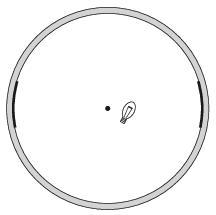
(5 pont)
solution (in Hungarian), statistics
P. 5309. Three uncharged metal spheres are placed to the vertices of an equilateral triangle of sides \(\displaystyle a\). The radius of the first, the second and the third sphere are \(\displaystyle R\), \(\displaystyle R\), and \(\displaystyle r = \frac13 R\), respectively. Each radius is much smaller than the side of the triangle. First the first sphere is charged to \(\displaystyle Q\), and then the other two spheres are also charged, by connecting the two ends of a long wire to the first and the third spheres and then connecting to the first and the second spheres. What will the direction of the electric field be at the centre of the equilateral triangle?
(4 pont)
solution (in Hungarian), statistics
P. 5310. An equilateral triangle is formed from a piece of insulated wire such that it can be rotated frictionlessly along the horizontal axis of \(\displaystyle OO'\). The wire is rigid and its mass per unit length is \(\displaystyle \lambda\). Initially the plane of the triangle is vertical, and it is in uniform vertical upward magnetic field of induction \(\displaystyle \boldsymbol B\). At a certain moment a voltage supply is connected to the system thus a current of \(\displaystyle I\) starts to flow in the wire. (Neglect the inductance of the wire.)
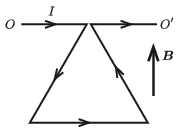
\(\displaystyle a)\) At what acceleration does the horizontal side of the triangle begin to move?
\(\displaystyle b)\) After a long enough time what will the angle between the plane of the triangle and the vertical be?
(5 pont)
solution (in Hungarian), statistics
P. 5311. The electric field at sea level is approximately 100 V/m, and the height of ionosphere is 10 km. The average magnetic induction of the Earth at sea level is \(\displaystyle 10^{-5}\) T, and its value is approximately indirectly proportional to the cube of the distance measured from the centre of the Earth. Estimate the order of the ratio of the magnetostatic and electrostatic energy around the Earth.
(5 pont)
solution (in Hungarian), statistics
P. 5312. We have two cylinder-shaped containers, the first contains a sample of monatomic gas of volume 3 dm\(\displaystyle {}^3\), at a pressure of \(\displaystyle 2\cdot10^5\) Pa, and the number of particles in it is \(\displaystyle 5\cdot10^{22}\). The second has a volume of 4 dm\(\displaystyle {}^3\) and contains a sample of diatomic gas of \(\displaystyle 2.5\cdot10^{22}\) particles at a pressure of \(\displaystyle 0.2\cdot 10^5\) Pa.
\(\displaystyle a)\) Which gas is warmer, and by what factor is the temperature of the warmer gas greater than that of the colder?
\(\displaystyle b)\) What is the energy of each sample of gas?
\(\displaystyle c)\) How much energy can be related to a gas particle and to one degree of freedom of a particle?
(3 pont)
solution (in Hungarian), statistics
P. 5313. A beam of protons is aimed at a target, which is at rest. If the kinetic energy of the protons in the beam is greater than a critical value of \(\displaystyle E_\text{crit}\), then the incident protons may generate positive pions (\(\displaystyle \pi^+\)) by colliding the protons of the target, which can be considered being at rest, accordingly the following equation:
\(\displaystyle \mathrm{p}^+ +\mathrm{p}^+ \Rightarrow\mathrm{p}^+ +\mathrm{n}^0 +\pi^+. \)
Determine the value of \(\displaystyle E_\text{crit}\) in MeV.
Available data: the rest energy of a proton is 938.27 MeV, the rest energy of a neutron is 939.57 MeV and the rest energy of a pion is 139.57 MeV.
(5 pont)
solution (in Hungarian), statistics
P. 5314. A vertical thermally insulated cylinder of cross sectional area \(\displaystyle A_0\) is open at its top and is divided into two parts by a thermally insulated piston of negligible width and mass. The part below the piston has a height of \(\displaystyle 2h_0\) and contains air. Above the piston there is some liquid of density \(\displaystyle \varrho\) and of height \(\displaystyle 2h_0\). Above the piston at a height of \(\displaystyle h_0\) a small hole of cross section \(\displaystyle A_1\) is opened at the beginning of the process, through which the liquid begins to flow out. The ambient atmospheric pressure is \(\displaystyle p_0=\varrho gh_0\).
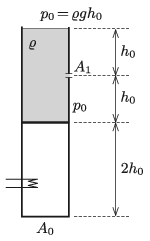
\(\displaystyle a)\) How should we change the power of the electric heating element which can heat the air below the piston in order that the fluid flow out at a constant rate?
\(\displaystyle b)\) For how long can we use the heating element to maintain the constant flow rate of the fluid, and after this time has elapsed why can't this be done with operating the heating element?
(6 pont)
Upload your solutions above.
